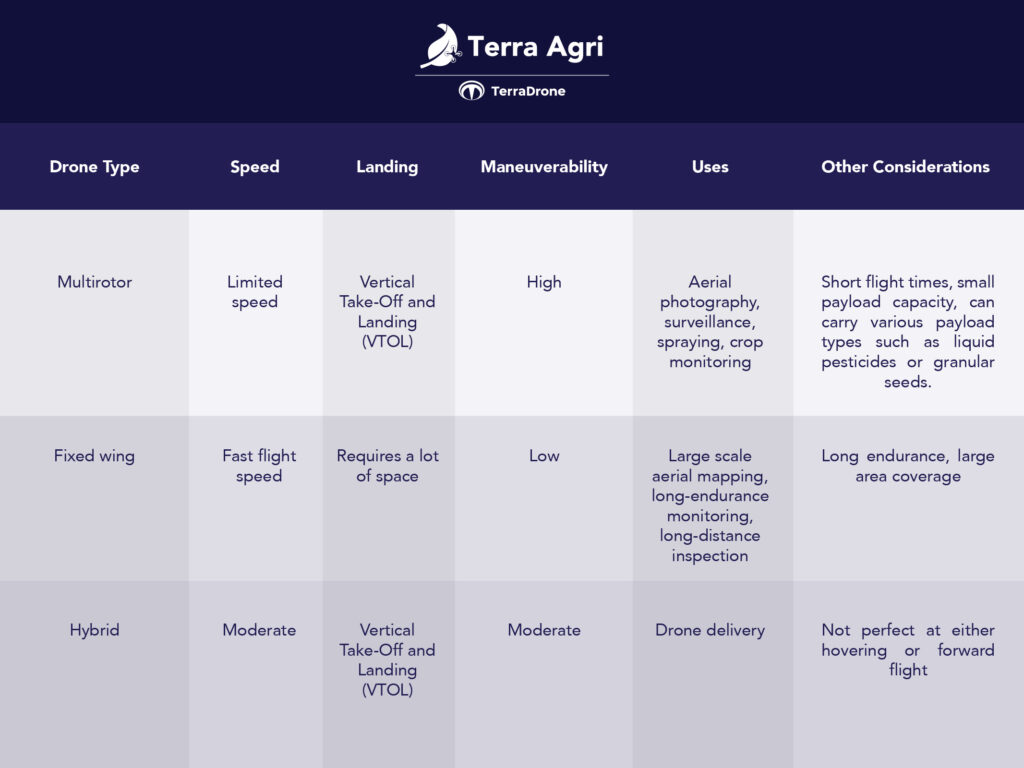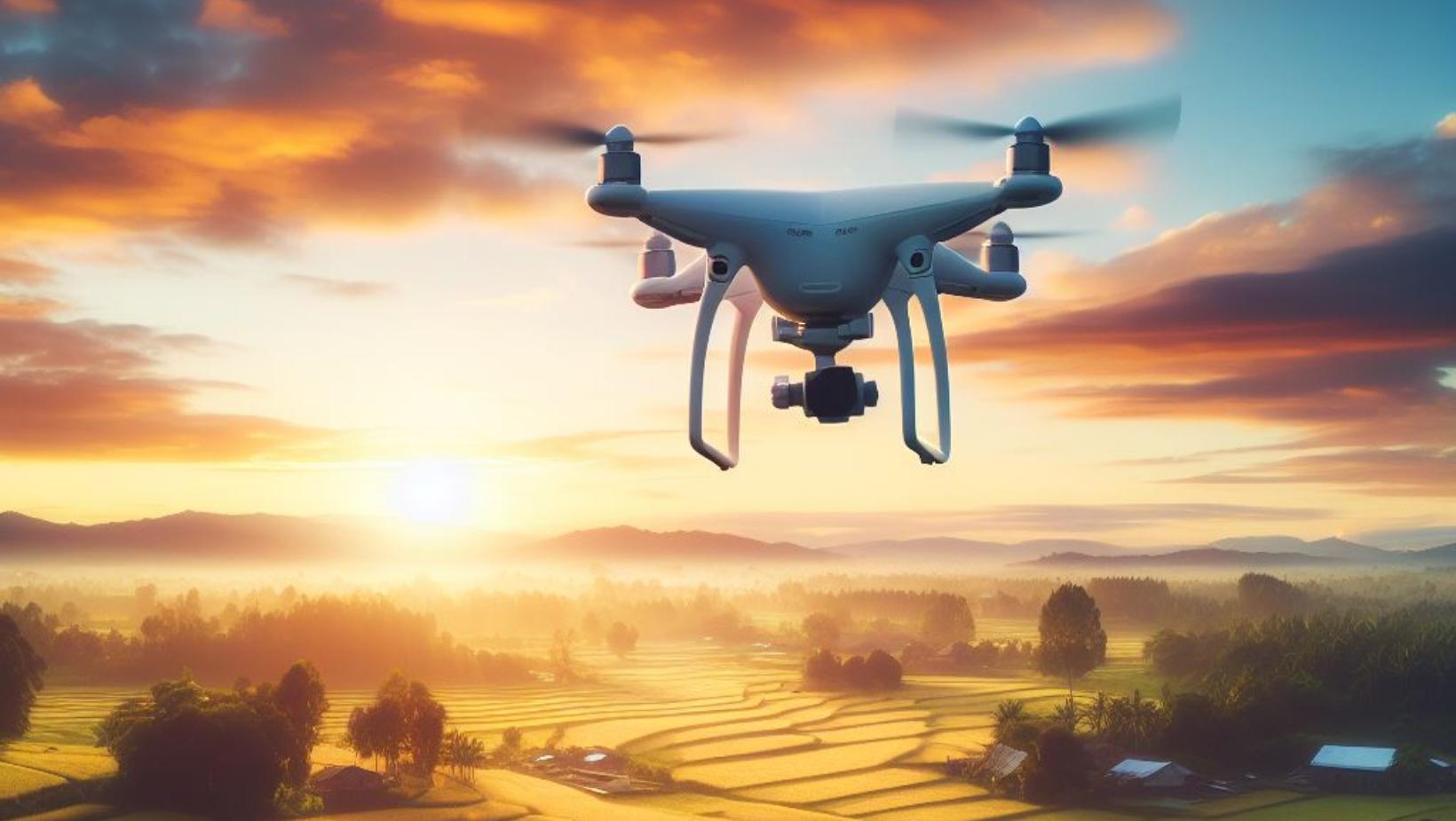Agricultural drones have revolutionized farming by providing agribusiness with advanced data collection and decision-making capabilities. It has increased efficiency, productivity, and sustainability in crop management. This guide will help you explore the most common types of drones used in agriculture, their characteristics, applications, as well as their advantages and limitations.
Different Kinds of Drones for Farming
Quadcopters: Definition and Applications
Quadcopters, or quadrotors, are uncrewed aerial vehicles (UAVs) with four rotors arranged in a square configuration. These highly maneuverable and versatile flying machines have various applications in agriculture due to their numerous advantages.
Quadcopters can fly at low altitudes and hover over crops, allowing for detailed inspection of the crops. They can capture high-resolution images and record videos that can be used to monitor crop health, detect stress, and identify diseases or pests.
Quadcopters are also ideal for mapping agricultural fields. With their advanced sensors and GPS technology, quadcopters can collect data about a field’s topography, soil moisture, and vegetation index. This data can be used to create detailed maps that help agribusiness make informed decisions about crop management.
Another significant advantage of quadcopters is their ability to spray pesticides and fertilizers accurately. Quadcopters equipped with streaming systems can fly close to the crops and apply the necessary chemicals precisely, reducing the chemicals used and minimizing the environmental impact.
Limitations of Quadcopters
Quadcopters provide several advantages, but it’s essential to consider their limitations too. The most significant limitation is their short battery life, which typically lasts between 20 to 30 minutes per flight. This short flying time can restrict their coverage area and require frequent battery replacements during large-scale agricultural operations. Moreover, due to their limited payload capacity, quadcopters have constraints on the amount of equipment and payload they can carry, such as cameras, sensors, and pesticide sprayers.
(Example of agriculture spraying drone. It’s quadcopter type by Terra Agri)
Fixed-wing Drones: Definition and Applications
The most common types of drones in agriculture is fixed-wing. Fixed-wing drones are Unmanned Aerial Vehicle (UAV) types with fixed-wing designs similar to traditional airplanes. Unlike quadcopters, fixed-wing drones generate lift by moving forward, allowing them to achieve longer flight endurance and cover larger areas in a single flight.
In the agricultural industry, fixed-wing drones are widely used for aerial mapping, crop scouting, and surveying vast farmlands. Their ability to cover vast areas efficiently makes them an ideal option for monitoring crop health, identifying areas of concern, and generating detailed maps for precision farming applications.
One of the most significant advantages of UAVs in farming over quadcopters is their extended flight endurance and more extensive coverage areas. Fixed-wing drones can fly for up to two hours or more, covering vast farmland areas in a single flight, reducing the need for frequent battery changes, and improving operational efficiency.
Limitations of Fixed-wing Drones
Fixed-wing drones possess impressive flight capabilities. However, they do have certain limitations. One of the primary limitations is that they require a runway or open space for takeoff and landing, which may not be feasible in confined or densely populated agricultural areas. Additionally, fixed-wing drones are typically less maneuverable than quadcopters, which makes them unsuitable for tasks that require close-range inspection or precise navigation around obstacles.
Hybrid Drones: Definition and Applications
Hybrid drones, which combine the features of quadcopters and fixed-wing drones, offer versatility and adaptability for agricultural purposes. Due to their vertical takeoff and landing capabilities, they can hover like quadcopters and cover large distances like fixed-wing drones. Hybrid drones are widely used for crop monitoring, mapping, and precision agriculture. They are ideal for farming environments of all sizes, from small-scale plots to expansive farmlands, as they can seamlessly switch between vertical and horizontal flight modes.
Hybrid drones have several advantages over traditional UAVs, including their flexibility in flight modes. This allows them to perform various tasks more efficiently and flexibly. For example, they can capture detailed aerial imagery of crops by hovering at low altitudes and then transition to fixed-wing flight mode to cover large areas in a single flight. Multiple UAVs are not required, which increases operational efficiency.
Limitations of Hybrid Drones
Hybrid drones offer fantastic versatility but have some limitations that require careful consideration. One of the critical drawbacks is their high complexity and cost. They are more intricate and expensive than traditional UAVs since they need advanced flight control systems and additional components to support vertical takeoff and landing capabilities. Furthermore, operating hybrid drones may require specialized training and expertise, which increases the entry barrier for agribusiness interested in adopting this technology.
Table of Comparing the Common Types of Drones in Agriculture

Factors to Consider When Choosing Agricultural Drones
Agribusinesses must consider several factors when selecting a drone for agricultural use. Firstly, the drone chosen should be appropriate for the size and terrain of their farm. Additionally, it should align with their specific farming tasks and objectives. Secondly, the drone should meet regulatory compliance and licensing requirements. Therefore, choosing a suitable drone requires careful evaluation and thorough research. Finally, agribusinesses can select the right drone model that meets their operational requirements and budget constraints.
Conclusion
Drones are now essential in modern agriculture, offering unprecedented data collection, monitoring, and decision-making capabilities. Additionally, we have explored the different types of drones used in agriculture, highlighting their applications, advantages, and limitations.
When choosing a drone, agribusiness should consider factors like farm size, specific tasks and objectives, budget, and regulatory compliance. Moreover, they can increase productivity and profitability by embracing drone technology while demonstrating their commitment to sustainable and responsible agricultural practices.
Furthermore, let’s continue to explore, innovate, and adopt precision agriculture drones to shape a brighter and more prosperous future for agriculture.

